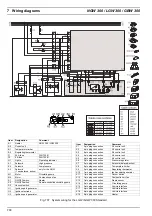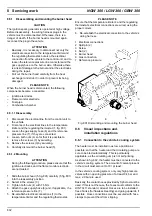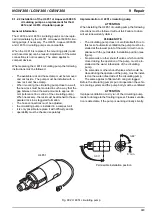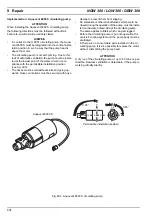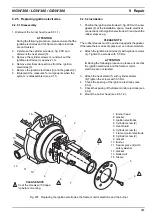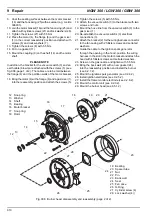
NGW 300 / LGW 300 / GBW 300
8 Servicing work
803
PLEASE NOTE
The hose clamps must be tightened with the required
torque.
Care must be taken to bleed the cooling system before the
heater is used for the first time or after renewal of the
coolant. The heater and lines should be installed in such
a way as to guarantee static bleeding.
Inadequate bleeding can lead to a breakdown while the
heater is in operation, due to overheating.
Flawless ventilation is detectable, if the pump is working
virtually silently.
8.6.2 Connection to the vehicle’s gas system
For the NGW 300 version, gas must be withdrawn from
the tank or from the immediate vicinity of the tank.
Withdrawing gas from the filler line and at places where oil
and condensate can accumulate is not permissible.
Extraction must be performed in such a way that the least
amount of oil and condensate possible can enter the
supply line to the heating system’s gas pressure regulator,
(outlet at the top).
For the LGW 300 version, the gas must be withdrawn in
its gas phase in the tank.
Only the original Spheros hose may be used for the
gasline on the low pressure side between the gas
pressure regulator and the heater.
When installing the hose, icare must be taken to ensure
that there is a sufficient distance (min. 25 mm) from the
outer casing of the heater and/or it must be shielded to
protect it from from the heat.
The hose must not be kinked or twisted.
8.6.3 Combustion air supply
Combustion air is taken in via the inlet grille in the burner
hood.
Care must be taken not to suck in any exhaust gas.
If the heater is installed in an enclosed installation box, a
ventilation opening of at least 100 cm
2
is required.
The combustion air intake line can be extended with a
special version of the heater. The permissible dimensions
of the combustion air intake line are as follows for this
version:
–
Internal diameter: 60 mm
–
Maximum permissible line length: 3 m without an
exhaust extension
–
Maximum permissible bend: 450°
Under no circumstances may the combustion air be taken
from spaces which accommodate people. The
combustion air intake opening must not point in the
direction n which the bus is traveling. It must be
positioned so that it cannot become clogged with dirt or
snow and cannot suck in splashing water.
The combustion air intake opening must be designed in
such a way thata sphere with a diameter of 16 mm cannot
fit into it. However, the inlet cross-section may not be
restricted.
If the combustion air intake line cannot be installed so that
it slopesdownwards, then a water drain hole with a
diameter of 4 mm is to be made at its lowest point.
8.6.4 Exhaust gas line
The exhaust pipe opening may not point in the direction in
which the bus is traveling.
The exhaust pipe opening must be positioned so that it
cannot become clogged with dirt or mud.
Rigid pipes of unalloyed or alloyed steel with a minimum
wall thicknessof 1.0 mm or flexible piping of alloyed steel
only must be used as exhaust lines. The exhaust pipe is
secured to the heater using a clamping collar.
Permissible dimensions:
–
Internal diameter: 70 mm
–
Maximum permissible line length: 3 m
–
Maximum permissible bend: 270°
An exhaust extension is only possible if the combustion
air intake line has not been extended.










